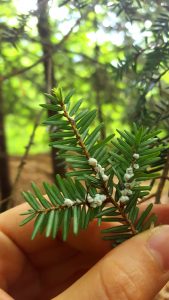
By Analise Sala ’19 and Micaela Wells ’19, Hope College
Travel has consequences. Thanks to an increasingly connected world, American forests house more than 360 non-native insect species, 30 percent of which have become serious pests.
By relocating and displacing organisms, we are effectively homogenizing our planet’s landscape in a period of great human influence on the environment that has been coined the “anthropocene.”
Many are aware of the emerald ash borer, an invasive Asian beetle. It was first discovered in 2002 in southeast Michigan, where by now it has killed over 99 percent of adult ash trees. The transport of firewood and nursery trees ensured quick spread from forest to forest throughout Michigan and the eastern U.S.
Dead trees all around Holland are symbols of this beetle’s destructive power.
This story is far from unique. Fewer than 15 years after the invasion of the emerald ash borer, a new insect threatens Michigan tree species. The invasive hemlock woolly adelgid has been discovered on Eastern hemlocks in West Michigan’s own dune forests.
And still another pest is knocking on our doors. The Asian longhorned beetle is devouring the heartwood of thousands of maples and other hardwood trees in neighboring Ohio and frequently hitches rides on human-transported firewood and shipping pallets.
These insects are not problematic in their home regions of highly interdependent systems. Home-range trees have evolved defenses against their longtime pests, and they can coexist with no danger of heavy infestation.
However, when the pests are transported away from their home regions, natural competitors and predators are left behind, allowing unchecked invasive populations to spread rapidly.
The danger, then, comes with us. Every tree, pallet, or pair of unwashed hiking boots moved from one place to another has the potential to introduce a new major player into an existing ecosystem. These major players can out-compete and displace multiple native species, reducing an area’s biodiversity.
We can best appreciate the local diversity of the places we visit by doing whatever we can to keep those places just that – local. Landscaping with local nursery stock, washing clothing after visiting the woods, and heeding those oft-overlooked Department of Natural Resources warnings against transporting
fish, firewood or soil are all great ways to slow the spread of invasives that threaten the unique ecosystems of our region.
We can also report the presence of invasive species to cooperatives like the![]() Midwest Invasive Species Information Network which work to monitor and control invasive species spread. (Visit www.misin.msu.edu/ for more information.)
Midwest Invasive Species Information Network which work to monitor and control invasive species spread. (Visit www.misin.msu.edu/ for more information.)
Undoubtedly, some pests will still spread, and scientists will need to explore new ways to combat those threats, but we can each help prevent the frequency at which they must do so. Explore and cherish our unique West Michigan ecosystems, but be mindful of what you take with you.
Analise Sala and Micaela Wells are summer student researchers working at Hope College under Drs. Vanessa Muilenburg, K. Greg Murray, and Kathy Winnett-Murray on the project “Direct and Indirect Impacts of a Developing Hemlock Woolly Adelgid Invasion in West Michigan Dune Forests.”

